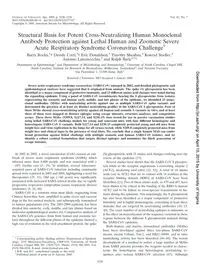
2008 Structural Basis for Potent Cross-Neutralizing Human Monoclonal Antibody Protection against Lethal Human and Zoonot PDF
Preview 2008 Structural Basis for Potent Cross-Neutralizing Human Monoclonal Antibody Protection against Lethal Human and Zoonot
JOURNAL OF VIROLOGY, Apr. 2008, p. 3220–3235 Vol. 82, No. 7 0022-538X/08/$08.00�0 doi:10.1128/JVI.02377-07 Copyright © 2008, American Society for Microbiology. All Rights Reserved. Structural Basis for Potent Cross-Neutralizing Human Monoclonal Antibody Protection against Lethal Human and Zoonotic Severe Acute Respiratory Syndrome Coronavirus Challenge� Barry Rockx,1† Davide Corti,2† Eric Donaldson,3 Timothy Sheahan,3 Konrad Stadler,4 Antonio Lanzavecchia,2 and Ralph Baric1,3* Department of Epidemiology1 and Department of Microbiology and Immunology,3 University of North Carolina, Chapel Hill, North Carolina; Institute for Research in Biomedicine, Bellinzona, Switzerland2; and Novartis Vaccines, Via Fiorentina 1, 53100 Siena, Italy4 Received 2 November 2007/Accepted 8 January 2008 Severe acute respiratory syndrome coronavirus (SARS-CoV) emerged in 2002, and detailed phylogenetic and epidemiological analyses have suggested that it originated from animals. The spike (S) glycoprotein has been identified as a major component of protective immunity, and 23 different amino acid changes were noted during the expanding epidemic. Using a panel of SARS-CoV recombinants bearing the S glycoproteins from isolates representing the zoonotic and human early, middle, and late phases of the epidemic, we identified 23 mono- clonal antibodies (MAbs) with neutralizing activity against one or multiple SARS-CoV spike variants and determined the presence of at least six distinct neutralizing profiles in the SARS-CoV S glycoprotein. Four of these MAbs showed cross-neutralizing activity against all human and zoonotic S variants in vitro, and at least three of these were mapped in distinct epitopes using escape mutants, structure analyses, and competition assays. These three MAbs (S109.8, S227.14, and S230.15) were tested for use in passive vaccination studies using lethal SARS-CoV challenge models for young and senescent mice with four different homologous and heterologous SARS-CoV S variants. Both S227.14 and S230.15 completely protected young and old mice from weight loss and virus replication in the lungs for all viruses tested, while S109.8 completely protected mice from weight loss and clinical signs in the presence of viral titers. We conclude that a single human MAb can confer broad protection against lethal challenge with multiple zoonotic and human SARS-CoV isolates, and we identify a robust cocktail formulation that targets distinct epitopes and minimizes the likely generation of escape mutants. In 2002 to 2003, a novel coronavirus (CoV) caused an out- break of severe acute respiratory syndrome (SARS), which infected more than 8,000 people and was associated with a �10% fatality rate (5, 19). In addition, several laboratory- acquired cases of SARS-CoV infection including community spread were reported in 2003 and 2004, highlighting a need for therapeutics (25, 31). Old age (�60 years) was significantly associated with increased SARS-related deaths due to rapidly progressive respiratory compromise (acute respiratory distress syndrome) (5, 26, 40). SARS-CoV is a zoonotic virus most likely originating from Chinese horseshoe bats, amplified in palm civets and raccoon dogs in the live-animal markets, and subsequently transmitted to human populations (16). The 2003-2004 epidemic has been divided into zoonotic, early, middle, and late phases based on molecular epidemiological studies (6). Comparative analysis of the SARS-CoV genomes from both human and zoonotic iso- lates throughout the different phases of the epidemic showed a high rate of evolution in the viral attachment protein, the spike (S) glycoprotein, with 23 amino acid changes evolving over the course of the epidemic (37). Several studies have shown that the SARS-CoV S glycopro- tein binds to the receptor angiotensin 1-converting enzyme 2 (ACE2), mediating viral entry (22, 52). A total of 18 amino acids (aa) in ACE2 that are in contact with 14 residues in the receptor binding domain (RBD) of SARS-CoV have been identified (21). Two of these amino acids, aa 479 and 487, have been shown to be critical in the binding of the RBD to human ACE2 and to be linked to cross-species transmission to hu- mans during the epidemic. Not surprisingly, the S glycoprotein has also been identified as a major component of protective immunity and is highly immunogenic, containing at least three domains that are targeted by neutralizing antibodies (10, 13, 20). The exact number of neutralizing epitopes is unknown, as is the effect on neutralization of the sequence variation in these regions between the different S glycoproteins isolated during the SARS-CoV epidemic. Both human and murine monoclonal antibodies (MAbs) have been developed against three late-phase SARS-CoV strains, strains Urbani, Tor-2, and HKU-39849, and in vitro neutralizing activity has been described (46–48). The recent development of a method to isolate a large number of MAbs from SARS patients provides the reagents needed to charac- terize the homologous and heterologous neutralizing re- sponses after natural SARS-CoV infection (47). Although * Corresponding author. Mailing address: Department of Epidemi- ology, 2107 McGavran-Greenberg, CB#7435, University of North Carolina, Chapel Hill, NC 27699-7435. Phone: (919) 966-3895. Fax: (919) 966-0584. E-mail:
